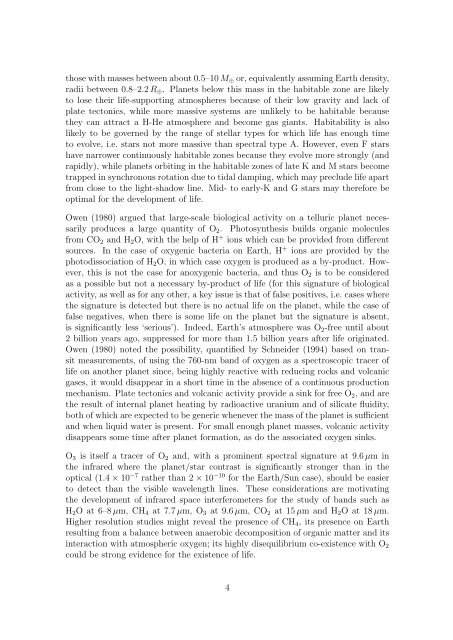Report - School of Physics
Report - School of Physics
Report - School of Physics
You also want an ePaper? Increase the reach of your titles
YUMPU automatically turns print PDFs into web optimized ePapers that Google loves.
those with masses between about 0.5–10 M ⊕ or, equivalently assuming Earth density,<br />
radii between 0.8–2.2 R ⊕ . Planets below this mass in the habitable zone are likely<br />
to lose their life-supporting atmospheres because <strong>of</strong> their low gravity and lack <strong>of</strong><br />
plate tectonics, while more massive systems are unlikely to be habitable because<br />
they can attract a H-He atmosphere and become gas giants. Habitability is also<br />
likely to be governed by the range <strong>of</strong> stellar types for which life has enough time<br />
to evolve, i.e. stars not more massive than spectral type A. However, even F stars<br />
have narrower continuously habitable zones because they evolve more strongly (and<br />
rapidly), while planets orbiting in the habitable zones <strong>of</strong> late K and M stars become<br />
trapped in synchronous rotation due to tidal damping, which may preclude life apart<br />
from close to the light-shadow line. Mid- to early-K and G stars may therefore be<br />
optimal for the development <strong>of</strong> life.<br />
Owen (1980) argued that large-scale biological activity on a telluric planet necessarily<br />
produces a large quantity <strong>of</strong> O 2 . Photosynthesis builds organic molecules<br />
from CO 2 and H 2 O, with the help <strong>of</strong> H + ions which can be provided from different<br />
sources. In the case <strong>of</strong> oxygenic bacteria on Earth, H + ions are provided by the<br />
photodissociation <strong>of</strong> H 2 O, in which case oxygen is produced as a by-product. However,<br />
this is not the case for anoxygenic bacteria, and thus O 2 is to be considered<br />
as a possible but not a necessary by-product <strong>of</strong> life (for this signature <strong>of</strong> biological<br />
activity, as well as for any other, a key issue is that <strong>of</strong> false positives, i.e. cases where<br />
the signature is detected but there is no actual life on the planet, while the case <strong>of</strong><br />
false negatives, when there is some life on the planet but the signature is absent,<br />
is significantly less ‘serious’). Indeed, Earth’s atmosphere was O 2 -free until about<br />
2 billion years ago, suppressed for more than 1.5 billion years after life originated.<br />
Owen (1980) noted the possibility, quantified by Schneider (1994) based on transit<br />
measurements, <strong>of</strong> using the 760-nm band <strong>of</strong> oxygen as a spectroscopic tracer <strong>of</strong><br />
life on another planet since, being highly reactive with reducing rocks and volcanic<br />
gases, it would disappear in a short time in the absence <strong>of</strong> a continuous production<br />
mechanism. Plate tectonics and volcanic activity provide a sink for free O 2 , and are<br />
the result <strong>of</strong> internal planet heating by radioactive uranium and <strong>of</strong> silicate fluidity,<br />
both <strong>of</strong> which are expected to be generic whenever the mass <strong>of</strong> the planet is sufficient<br />
and when liquid water is present. For small enough planet masses, volcanic activity<br />
disappears some time after planet formation, as do the associated oxygen sinks.<br />
O 3 is itself a tracer <strong>of</strong> O 2 and, with a prominent spectral signature at 9.6 µm in<br />
the infrared where the planet/star contrast is significantly stronger than in the<br />
optical (1.4 × 10 −7 rather than 2 × 10 −10 for the Earth/Sun case), should be easier<br />
to detect than the visible wavelength lines. These considerations are motivating<br />
the development <strong>of</strong> infrared space interferometers for the study <strong>of</strong> bands such as<br />
H 2 O at 6–8 µm, CH 4 at 7.7 µm, O 3 at 9.6 µm, CO 2 at 15 µm and H 2 O at 18 µm.<br />
Higher resolution studies might reveal the presence <strong>of</strong> CH 4 , its presence on Earth<br />
resulting from a balance between anaerobic decomposition <strong>of</strong> organic matter and its<br />
interaction with atmospheric oxygen; its highly disequilibrium co-existence with O 2<br />
could be strong evidence for the existence <strong>of</strong> life.<br />
4
















